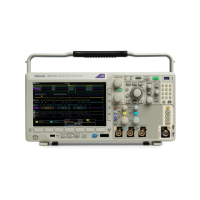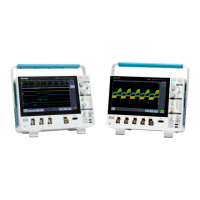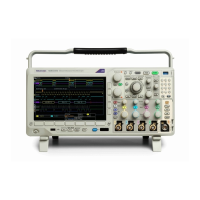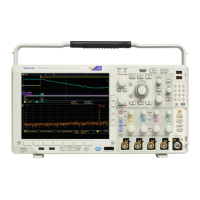
Do you have a question about the Tektronix MDO3034 and is the answer not in the manual?
| Brand | Tektronix |
|---|---|
| Model | MDO3034 |
| Category | Test Equipment |
| Language | English |
Summarizes safety precautions to avoid injury and prevent product damage, emphasizing user responsibility and proper usage.
Provides essential safety information for qualified personnel performing service procedures on the product.
Highlights the main capabilities and features of the MDO3000 Mixed Domain Oscilloscopes.
Instructions for unpacking and checking standard accessories before installing the oscilloscope.
Explains how to connect different types of Tektronix probes to the oscilloscope's input channels.
Provides step-by-step instructions for powering on the oscilloscope, including grounding.
Procedure for automatically compensating specific passive voltage probes for accurate measurements.
Information on how to upgrade the instrument's analog bandwidth by purchasing and installing an upgrade.
Corrects DC inaccuracies caused by temperature variations and long-term drift for accurate measurements.
Provides step-by-step instructions for updating the oscilloscope's firmware via USB.
Explains methods for connecting the oscilloscope to a PC for data analysis and remote control.
Overview of the front panel layout, including buttons, controls, and connectors.
Detailed explanation of how to use the menu system and front panel controls for operation.
Explains the function of various menu buttons on the front panel for performing operations.
Automatically sets vertical, horizontal, and trigger controls for a usable, stable display.
Steps to set up analog channels, including connecting probes and adjusting controls for signal acquisition.
Automatically adjusts acquisition, trigger, and vertical controls for optimal waveform display.
Explains different analog acquisition modes: Sample, Peak Detect, Hi Res, Envelope, and Average.
Instructions for decoding and triggering on serial or parallel bus signals with application modules.
Using horizontal and vertical controls to scale and position waveforms for analysis.
Setting coupling, termination, invert, bandwidth, and labels for input channels.
Taking automatic measurements like Frequency, Period, Rise Time on waveforms.
Taking automatic measurements in the frequency domain, such as channel power.
Using the digital voltmeter to measure potential difference between two points in a circuit.
Breaking down signals into component frequencies using Fast Fourier Transform (FFT).
Tools for efficiently working with long record length waveforms, including zoom and pan.
Monitoring signals against masks for pass/fail results, creating custom masks.
Acquiring, measuring, and analyzing power signals with the Power Analysis Module.
Enhances security with password protection for instrument control and port access.
Using the TekSecure function to erase all setup and waveform information from memory.
Instructions for connecting cables and using the AFG button to access the generator.
Steps to select and configure waveform types like Sine, Square, Pulse, and Noise.
Creating custom arbitrary waveforms from internal memories, channels, files, or templates.
Safety precautions to avoid potential hazards when using the P6316 logic probe.











